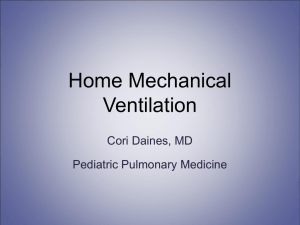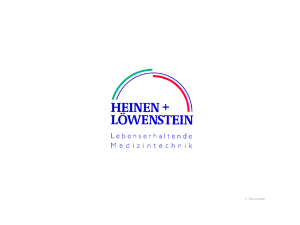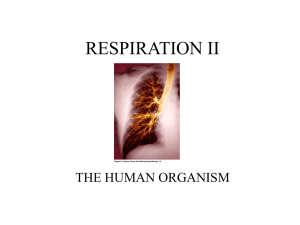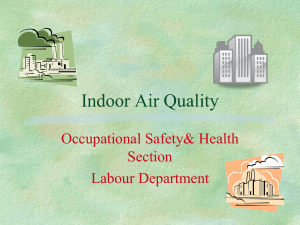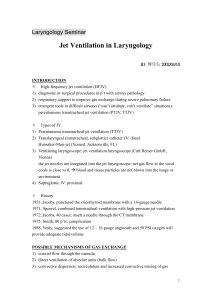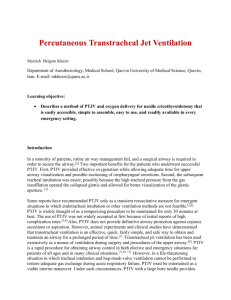Micro-laryngoscopy definition:
advertisement
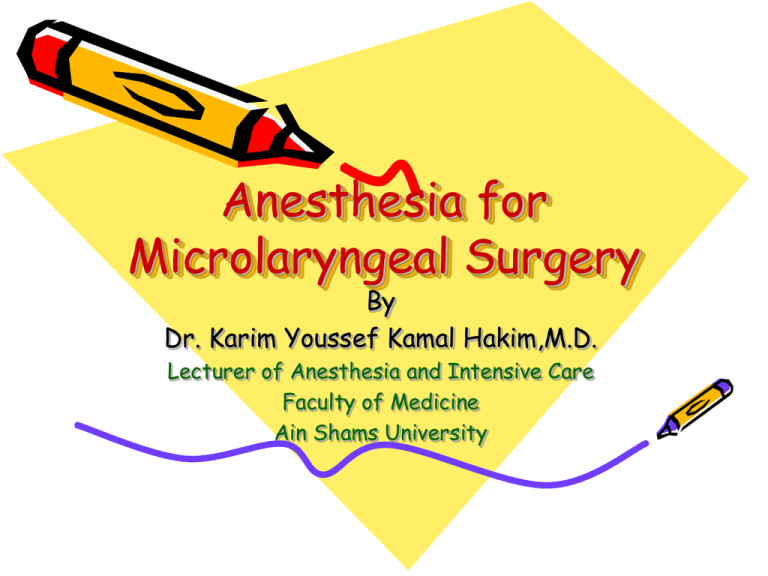
Anesthesia for Microlaryngeal Surgery By Dr. Karim Youssef Kamal Hakim,M.D. Lecturer of Anesthesia and Intensive Care Faculty of Medicine Ain Shams University Micro-laryngoscopy definition: It is surgery in larynx by laryngoscope aided by an operating microscope. Inflammatory laryngeal polyp: Anesthetic problems: • Patients with upper airway problems. • It is usually done as an outpatient procedure. • Profound muscle relaxation is needed. • Oxygenation and ventilation. • CVS instability. • Postoperative spasm or edema. Preoperative Management: Careful preoperative assessment for airway problems e.g. obstructing tumors, vocal cord polyps. • By history, examination and investigations as CT scan or MRI. • All equipment for difficult intubation should available preoperatively. Premedication: • Sedatives are avoided if any degree of airway obstruction is suspected. • Anticholinergics are used to decrease secretions and avoid bradycardia. Intra-operative Management: It may be an outpatient procedure so consider its precautions. 1. Profound muscle relaxation: • It is done usually by short acting nondepolarizing muscle relaxants ( as it is usually a short procedure). • In children, spontaneous ventilation without muscle relaxant may be used. 2 . Oxygenation and Ventilation: 1. • Micro-Laryngeal tracheal tube or Mallinckrodt Critical Care Tube: It is the most commonly used. It can be used orally or nasaly. • It is 4,5 or 6 mm I.D., but with the same adult length (31 cm) and with a large high volume low pressure cuff ( filled with 10 ml ) and is stiffer ( less prone to compression). Advantages: • Its small size will not impede the surgeon´s view. • Its cuff will prevent aspiration of blood or debris. • It allows introduction of inhalational agents • It allows monitoring of ET CO2. 2. Conventional E.T.T. of small size: • • Use one size smaller in children. Use size 4, 5 or 6 mm I.D in adults. • • It is too short for the adult trachea. It is with low volume cuff that will exert high pressure against the trachea. Disadvantages: 3. Pollards Tracheal Tube: • • It is formed latex reinforced with nylon spiral. Its proximal end size is 10 mm ID and distal end size is 5-7 mm ID. IN (1),(2),(3): Induction: Short acting opioids +thiopentone + suxamethonium or short acting non-depolarizing muscle relaxant + spraying the vocal cord with 3 ml lidocaine to assist smooth anesthesia. Maintenance: O2 and NO2 + volatile agents + controlled ventilation 4. Insufflation of high flow O2 : Via a small catheter placed in the trachea. Patients breath spontaneously. 5. Intermittent- Apnea technique: • The ventilation and anesthesia are maintained with O2 and a potent volatile agent by a face mask or E.T.T. for periods which alternate with periods of apnea during which the surgery is performed, usually 2-3 min. • Pulse-oximeter is essential. • There is risk of hypoventilation and aspiration. Advantages: Immobile unobstructed surgical field. Safety use of laser surgery. Disadvantages: Risk of aspiration of blood and debris. Variable levels of anesthesia. Interruption to surgery for reintubation. Potential trauma through repeated intubation. 6. Manual jet ventilation: • It is connected to a side port of the laryngoscope. • During inspiration ( 1-2 sec ), the jet pressure increases gradually, starting with; 15-20 psig in adults. 5-10 psig in infants and children. (psig = pound square inch gram) Then increase the pressure gradually until adequate chest rise and fall is noted. While the O2 source is directed through the glottic opening , it entrains room air into the lung ( venturi effect ) . • Expiration is allowed passively in ( 4-6 seconds ). • It is important to monitor the chest wall motion constantly for proper tidal volume assessment and to allow sufficient time for exhalation to avoid air trapping. Low Frequency Jet Ventilation Complications: 1. Air trapping and barotrauma resulting in pneumothorax, pneumo-mediastinum or subcutaneous emphysema. 2. Gastric dilatation with possible regurgitation. 3. Drying of mucosal surface. 4. Aspiration of resected material. 5. Complete respiratory obstruction. Contraindications: 1. Airway obstruction without tracheostomy. 2. Obesity. 3. Increased risk of aspiration. 4. Advanced COPD patients. 5. It is not suitable for removal of foreign body. 7. High-Frequency jet technique: • It is a variation of manual jet ventilation. • It utilizes a small cannula or tube in the trachea through which gas is injected at 80-300 times per minute. ( IN 6,7 ) TIVA is needed for induction and maintainance. Supraglottic jet ventilation Disadvantages Risk of barotrauma . Gastric distension. Misalignment of the rigid suspension laryngoscope resulting in poor ventilation. Blowing of blood and debris into the distal trachea. Inability to monitor end tidal CO2. Subglottic jet ventilation Advantages: Reduced peak airway pressure. No vocal cord motion. Good surgical field. Disadvantages: Greater risk of barotrauma. Transtracheal jet ventilation Disadvantages: Barotrauma, blockage, kinking infection, bleeding, failure to site the catheter. External high frequency oscillation 3. Cardiovascular instability: ABP and HR fluctuate markedly during laryngoscopy and may need invasive ABP monitoring because: • Many patients are heavy smokers or alcohol drinkers which predisposes them to CVS disease. • The procedure resembles a series of stress-filled laryngoscopies and intubations separated by varying periods of minimal surgical stimulation. So, maintain stable CV system by : • Supplementation with short acting anesthetics e.g. propofol or sympathetic antagonist e.g. esmolol ( during periods of stimulation). • Regional laryngeal nerve block e.g. Glosso-pharyngeal nerve ( at the posterior tonsillar pillar). • Topical anesthesia of the larynx with spraying lidocaine. Postoperative Management: • Laryngeal edema can occur in the early postoperative period, and it is usually manifested by retractions and respiratory stridor in the recovery room. • Laryngospasm can develop because of laryngeal hyperactivity. If it happens , it is treated with positive pressure mask ventilation with 100% O2. More severe cases of laryngospasm may require the use of a small, subapneic dose of succinylcholine ( 0.1 to 0.2 mg/Kg IV ). • Pneumothorax should be considered after all cases involving jet ventilation. • Pulmonary complications as a result of retained secretions and subsequent atelectasis have been reported. Questions 1. Day case surgery is appropriate for: c. d. ASA п patients. Accompanied patients who do not have a telephone. a. b. Operations lasting up to 3 hours. Babies < 6 months. 2. All of the following drugs used as a premedication except: a. b. c. d. Atropine. Metoclopramide. Corticosteroids. Diazepam. 3. One of the following drugs is used as muscle relaxant: a. b. c. d. succinylcholine. Pipecuronium. Pancuronium. Doxacurium. 4. All of the following are contraindications for manual jet ventilation except: • • • • Obesity. COPD. Vocal cord polyp. Patient is not fasting. 5. One of the following drugs is not used in microlaryngeal surgery in adults: a. b. c. d. Esmolol. Propofol. Ketamine. Atracurium. a. b. c. d. Laryngeal edema. Laryngeal spasm. Pneumothorax. Pulmonary embolism. 6. Complications that may occur in postoperative period after vocal cord tumour biopsy are all of the following except: THANK YOU





